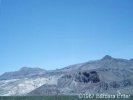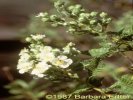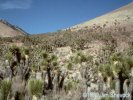 Carl Purpus, Plant Collector in
Western America
Carl Purpus, Plant Collector in
Western America 
Carl A. Purpus Translation by Barbara
Ertter






|
Original Title Bericht uber meine diesjahrige Sammeltour durch die sudostliche Sierra Nevada von Californien Von C. A. Purpus. Daunt Tulare Co. Calif. Mitt. Deutsch. Dendrol. Ges. 5: 229-235.
|
In Cottonwood Creek Canyon itself, and in a rocky side canyon on the banks of a small stream, I happened upon the rare and interesting Forestiera neomexicana A. Gray. Many plants of this
species looked just like F. acuminata Poir; others looked more like Ilex decidua Wats. I also found Prunus fasciculata A. Gray, a shrubby Malvaceae, shrubby Eriogonum, Penstemon, and many others.
|
|  North end of Coso Mountains.
North end of Coso Mountains.
Locations: Coso Mountains. On
another excursion all the way to the base of the volcanic Coso Mountains, which lay to the southwest of Owens Lake, I found, in addition to various very interesting splendid shrubs, a magnificent treelike Yucca. It grew mostly together in clusters, and gave the landscape a remarkable and interesting aspect. It is probably Yucca macrocarpa.
|
|  Mount Whitney from Lone Pine Creek.
Mount Whitney from Lone Pine Creek.
Locations: Corcoran Peak. Mount Whitney. Letters: 12/19/1896 After remaining for several weeks
in this very interesting region, we began our return trip. We
spent several days on "Old Mount Whitney" or Corcoran Peak, after which we climbed Mount Whitney, which rose to the north and is considered the highest peak in the United States. I did not encounter any new woody plants here. The view from the massive summit of reddish white granite, interspersed with gneiss at the peak, is magnificent, extending over a large portion of the Sierra Nevada. To the east could be seen the Jago, Panamint, Coso, Argus, Funeral, and White Mountains, which partly lay inside the Nevada border.
|
| From here we
travelled slowly back, stopping for 8-14 days at various botanically interesting
spots. I arrived at the departure point of my journey on the beginning of September, after which I
returned once again to Cottonwood Creek Canyon to collect various significant plants that grew only
there, including seeds of Chamaebatiaria millefolium and the splendid Opuntia. It was not a pleasant undertaking so late in the year.
|
| Letters: 9/15/1896
*************************************************************** |
|
Yesterday, on the 25th of October, I returned from my second journey to where the
Chamaebatiaria and Opuntia were. The nearly 300-mile-long trip proceeded without mishap. I obtained seeds of the lovely Chamaebatiaria millefolium at an elevation of 8000 feet, likewise joints and seeds of the wonderful Opuntia. I also gathered seeds of an additional 20 to 25 marvelous shrubs at similar high altitudes.
|
|  Chamaebatiaria millefolium.
Chamaebatiaria millefolium. Other Articles: Collecting in the Sierra Nevada: 0130 On the Trail…: 0250
I find Chamaebatiaria millefolium to be one of the loveliest shrubs in the eastern Sierra Nevada.
A more beautiful shrub than this magnificent one cannot be imagined. It is rather leafy and covered
with long panicles of mostly white flowers, yellow or brown at the base.
|
|  Joshua Tree Woodland near Walker Pass.
Joshua Tree Woodland near Walker Pass.
Locations: Argus Mountains. Argus Range. Coso Mountains. Walker Pass.
The journey over the high mountains was risky on account of the commencement of the snow
storm season. I therefore decided to take Walker Pass, a low crossing of the mountains some 60 miles from here [Springville]. From there I travelled northward, the Argus and Coso mountains to the east, the sharply incised bare peaks of the Sierra to the west, to a region where I had made my marvelous discovery that summer. The stands of "Yucca arborea" which occurred on the west and east sides of Walker Pass were extremely interesting. Also highly interesting and distinctive was that part of the desert bounded to the east by mountains and interrupted in many places by solitary or clustered craters.
|
|  North end of Coso Mountains.
North end of Coso Mountains.
Locations: Coso Mountains. Letters: 10/27/1896
On my return trip I explored the Coso Mountains and found there a very interesting shrubby flora
and many annuals. Unfortunately, all but a few of the latter were dead. There was also a singularly
beautiful Echinocactus sp. completely covered with rose-red spines that was absolutely magnificent! I collected seeds and plants of it. The journey was blessed with perfect weather and lasted about three weeks.
|
| Letters: 10/27/1896
| |
[Previous Page] | |
| [Published Biographies] [Travelogues and Articles] [Letters] [Plant Lists and Bibliography] [Site Administration] | | Date and time this article was prepared: 6/7/2002 7:32:10 PM |